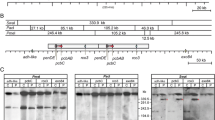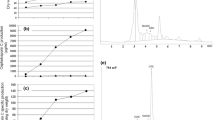Abstract
The transcription start points of the penicillin biosynthesis genes from Penicillium chrysogenum were mapped using the primer extension method. For each of the three genes consensus sequences of the core promoter elements were identified, supporting the notion that the basal transcription of these genes is mediated separately. Interestingly, transcription start of the pcbC gene is located within the potential Inr element with no TATA box-like sequence being found at expected position. This is in contrast to pcbAB and penDE genes with proposed TATA boxes or even to Aspergillus nidulans ipnA (pcbC) gene indicating possible differences in basal transcription regulation. Using the quantitative RT-PCR analysis the expression of all three biosynthesis genes was monitored in both the high and low production strain of P. chrysogenum during a 3-d cultivation under production conditions. The differences were found between the strains in time regulation and transcript levels of the biosynthesis genes. Furthermore, we showed that the effect of higher gene dosage on productivity in the production strain is amplified by more efficient transcription of the biosynthesis genes with the RNA levels ≈37- and 12-times higher, respectively, than in a low production strain.
Similar content being viewed by others
References
Aharonowitz Y., Cohen G., Martín J.F.: Penicillin and cephalosporin biosynthetic genes: structure, organization, regulation, and evolution. Ann.Rev.Microbiol. 46, 461–495 (1992).
Barredo J.L., Cantoral J.M., Alvarez E., Díez B., Martín J.F.: Cloning, sequence analysis and transcriptional study of the isopenicillin N synthase of Penicillium chrysogenum AS-P-78. Mol.Gen.Genet. 216, 91–98 (1989).
Brakhage A.A., Browne P., Turner G.: Regulation of Aspergillus nidulans penicillin biosynthesis and penicillin biosynthesis genes acvA and ipnA by glucose. J.Bacteriol. 174, 3789–3799 (1992).
Brakhage A.A.: Molecular regulation of β-lactam biosynthesis in filamentous fungi. Microbiol.Mol.Biol.Rev. 62, 547–585 (1998).
Brakhage A.A., Spröte P., Al-Abdallah Q., Gehrke A., Plattner H., Tüncher A.: Regulation of penicillin biosynthesis in filamentous fungi. Adv.Biochem.Eng.Biotechnol. 88, 45–90 (2004).
Chu Y.W., Renno D., Saunders G.: Detection of a protein which binds specifically to the upstream region of the pcbAB gene in Penicillium chrysogenum. Curr.Genet. 27, 184–189 (1995).
Díez B., Gutiérez S., Barredo J.L., van Solingen P., Lucia H.M., van der Voort L.H.M., Martín J.F.: The cluster of penicillin biosynthesis gene. Identification and characterization of the pcbAB gene encoding the α-(aminoadipylcysteinyl)-valine synthetase and linkage to the pcbC and pen DE genes. J.Biol.Chem. 256, 16358–16365 (1990).
Elander R.P.: Industrial production of α-lactam antibiotics. Appl.Microbiol.Biotechnol. 61, 385–392 (2003).
Feng B., Friedlin E., Marzluf G.A.: A reporter gene analysis of penicillin biosynthesis gene expression in Penicillium chrysogenum and its regulation by nitrogen and glucose catabolite repression. Appl.Environ.Microbiol. 60, 4432–4439 (1994).
Feng B., Friedlin E., Marzluf G.A.: Nuclear DNA-binding proteins which recognize the intergenic control region of penicillin biosynthetic genes. Curr.Genet. 27, 351–358 (1995).
Fernández-Cañón J.M., Peñalva M.A.: Overexpression of two penicillin structural genes in Aspergillus nidulans. Mol.Gen.Genet. 246, 110–118 (1995).
Gunnarsson N., Eliasson A., Nielsen J.: Control of fluxes towards antibiotics and the role of primary metabolism in production of antibiotics. Adv.Biochem.Eng.Biotechnol. 88, 137–178 (2004).
Gutiérrez S., Díez B., Alvarez E., Barredo J.L., Martín J.F.: Expression of the penDE gene of Penicillium chrysogenum encoding isopenicillin N acyltransferase in Cephalosporium acremonium: production of benzylpenicillin by the transformants. Mol.Gen.Genet. 225, 56–64 (1991).
Gutiérrez S., Fierro F., Casqueiro J., Martín J.F.: Gene organization and plasticity of the β-lactam genes in different filamentous fungi. Antonie van Leeuwenhoek75, 81–94 (1999).
Kormanec J.: Analyzing the developmental expression of sigma factors with S1-nuclease mapping, pp. 481–494 in C.H. Chein (Ed.): Nuclease Methods and Protocols: Methods in Molecular Biology. Humana Press, Totowa (NJ, USA) 2001.
Kosalková K., Marcos A.T., Fierro F., Hernando-Rico V., Gutiérrez S., Martín J.F.: A novel heptameric sequence (TTA GTAA) is the binding site for a protein required for high level expression of pcbAB, the first gene of the penicillin biosynthesis in Penicillium chrysogenum. J.Biol.Chem. 275, 2423–2430 (2000).
Kosalková K., Rodríguez-Sáiz M., Barredo J.L., Martín J.F.: Binding of the PTA1 transcriptional activator to the divergent promoter region of the first two genes of the penicillin pathway in different Penicillium species. Curr.Genet. 52, 229–237 (2007).
Kosalková K., García-Estrada C., Ullán R.V., Godio R.P., Feltrer R., Teijeira F., Mauriz E., Martín J.F.: The global regulator LaeA controls penicillin biosynthesis, pigmentation and sporulation, but not roquefortine C synthesis in Penicillium chrysogenum. Biochimie91, 214–225 (2009).
Leiter E., Emri T., Gyémánt G., Nagy I., Pócsi I., Winkelmann G., Pócsi I.: Penicillin V production by Penicillium chrysogenum in the presence of Fe3+ and in low-iron culture medium. Folia Microbiol. 46, 127–132 (2001).
Litzka O., Bergh K.T., Brakhage A.A.: Analysis of the regulation of Aspergillus nidulans penicillin biosynthesis gene aat (penDE) encoding acyl coenzyme A:6-aminopenicillanic acid acyltransferase. Mol.Gen.Genet. 249, 557–569 (1995).
Martín J.F.: Molecular control of expression of penicillin biosynthesis genes in fungi: regulatory proteins interact with a bidirectional promoter region. J.Bacteriol. 182, 2355–2362 (2000).
Nemec P., Baráth Z., Betina V., Kutková M.: Antibiotic activity of fungi isolated from soil samples from Indonesia. Folia Microbiol. 9, 383–386 (1964).
Nielsen J.: Physiological engineering aspects of Penicillium chrysogenum. World Scientific Publishing, Singapore 1997.
Nüesch J., Heim J., Treichler H.-J.: The biosynthesis of sulfur containing β-lactam antibiotics, Ann.Rev.Microbiol. 41, 51–75 (1987).
Pérez-Esteban B., Orejas M., Gómez-Pardo E., Peñalva M.A.: Molecular characterization of a fungal secondary metabolism promoter: transcription of the Aspergillus nidulans isopenicillin N synthetase gene is modulated by upstream negative elements. Mol.Microbiol. 9, 881–895 (1993).
Revilla G., López-Nieto M.J., Luengo J.M., Martín J.F.: Carbon catabolite repression of penicillin biosynthesis by Penicillium chrysogenum. J.Antibiot. 37, 781–789 (1984).
Rodríguez-Sáiz M., Díez B., Barredo J.L.: Why did the Fleming strain fail in penicillin industry? Fungal Genet.Biol. 42, 464–470(2005).
Skovierova H., Rowley G., Rezuchova B., Homerova D., Lewis C., Roberts M., Kormanec J.: Identification of the σE regulon of Salmonella enterica serovar Typhimurium. Microbiology152, 1347–1359 (2006).
Smith D.J., Bumham M.K.R., Bull J.H., Hodgson J.E., Ward J.M., Browne P., Brown J., Barton B., Earl A.J., Turner G.: β-Lactam antibiotic biosynthetic genes have been conserved in clusters in prokaryotes and eukaryotes. EMBO J. 9, 741–747 (1990a).
Smith D.J., Earl A.J., Turner G.: The multifunctional peptide synthetase performing the first step of penicillin biosynthesis in Penicillium chrysogenum is a 421 073 dalton protein similar to Bacillus brevis peptide antibiotic synthetases. EMBO J. 9, 2743–2750 (1990b).
Spížek J., Tichý P.: Some aspects of overproduction of secondary metabolites. Folia Microbiol. 40, 43–50 (1995).
Theilgaard H.B., van den Berg M., Mulder C., Bovenberg R., Nielsen J.: Quantitative analysis of Penicillium chrysogenum Wis54-1255 transformants overexpressing the penicillin biosynthetic genes. Biotechnol.Bioeng. 72, 379–388 (2001).
Author information
Authors and Affiliations
Corresponding author
Rights and permissions
About this article
Cite this article
Šmidák, R., Jopčík, M., Kralovičová, M. et al. Core promoters of the penicillin biosynthesis genes and quantitative RT-PCR analysis of these genes in high and low production strain of Penicillium chrysogenum . Folia Microbiol 55, 126–132 (2010). https://doi.org/10.1007/s12223-010-0019-4
Received:
Revised:
Published:
Issue Date:
DOI: https://doi.org/10.1007/s12223-010-0019-4




